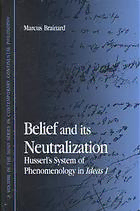
Belief and its neutralization : Husserl's system of phenomenology in Ideas I PDF
Preview Belief and its neutralization : Husserl's system of phenomenology in Ideas I
Belief and its Neutralization SUNY series, in Contemporary Continental Philosophy Dennis J. Schmidt, editor Belief and its Neutralization (cid:1) Husserl’s System of Phenomenology inIdeas I Marcus Brainard State University of New York Press Cover image: “Husserl’s last manuscript page.” From Hans Rainer Sepp, ed., Edmund Husserl und die phänomenologische Bewegung (Freiburg/Munich: Alber, 1988), p. 412. Permission to reproduce it was granted by the Husserl Archive in Leuven, Belgium. p. vii. Albrecht Dürer, “Knight, Death, and the Devil” (1513). From the Konrad Liebmann- Stiftung in the Stiftung Niedersachen at the Kulturgeschichtliches Museum Osnabrück. p. viii. Rembrandt, “Jacob Wrestling with the Angel” (ca. 1659/60). From the Staatliche Museen zu Berlin Preussischer Kulturbesitz, Gemäldegallerie. Published by State University of New York Press, Albany © 2002 State University of New York All rights reserved Printed in the United States of America No part of this book may be used or reproduced in any manner whatsoever without written permission. No part of this book may be stored in a retrieval system or transmitted in any form or by any means including electronic, electrostatic, magnetic tape, mechanical, photocopying, recording, or otherwise with- out the prior permission in writing of the publisher. For information, address State University of New York Press, 90 State Street, Suite 700, Albany, NY 12207 Production by Judith Block Marketing by Michael Campochiaro Library of Congress Cataloging-in-Publication Data Brainard, Marcus. Belief and its neutralization : Husserl’s system of phenomenology in Ideas I / Marcus Brainard. p. cm. —(SUNY series in contemporary continental philosophy) Includes bibliographical references (p. ) and indexes. ISBN 0–7914–5219–0 (alk. paper) — ISBN 0–7914–5220–4 (pbk. : alk. paper) 1. Husserl, Edmund, 1859–1938. Allgemeine Einfèhrung in die reine Phènomenologie. 2. Phenomenology. I. Title. II. Series. B3279.H93 A3333 2002 142’.7—dc21 2001049416 10 9 8 7 6 5 4 3 2 1 For my parents “. . . nihil esse perniciosius quam quicquid ibi est accipi ad litteram, id est ad verbum, nihil autum salubrius quam spiritu revelari.” (“. . . nothing is more pernicious than that whatever is there be taken by the letter, that is, literally, but nothing is more salubri- ous than that it be revealed through the spirit.”) — Augustine, De utilitate credendi (cid:1) Contents Preface xiii I. Introduction: The Task of Thinking 1 1. The Idea of Phenomenology 5 1.1The Crisis, its Source and Dimensions 6 1.2 Natural Order and Critique 8 1.3 System and Norms 11 1.4 Ethos, Ought, Teleology 14 2. The System of Husserlian Phenomenology: Ideas I 21 2.1 Polarities 24 2.2 The Order of Critique 26 2.3 The Whole and its Parts 27 II. Phenomenological Propaedeutics 33 1. Logical Considerations: Matter of Fact and Essence 37 1.1 The Realm of the Natural 38 1.2 Individual and Essence, Possibility and Necessity 40 1.3 Factual and Eidetic Sciences 45 2. Between Scylla and Charybdis: The Principle of All Principles 48 2.1 Phenomenology and Philosophy 48 2.2 Empiricism, Naturalism, Skepticism 50 2.3 Idealism 53 2.4 The Blindness of Theory 53 2.5 The First Principle 54 2.6 Dogmatism 56 3. The Epoché and the Phenomenological Reductions 57 3.1 The Attitudes of Consciousness 59 3.2 The General Thesis 60 3.3 The Instrumentalization of Cartesian Doubt 62 3.4 The Attitudinal Leap 65 3.5 The Family of Reductions 68 3.6 The Primacy of the Universal Epoché 74 (cid:2) (cid:1) ix
